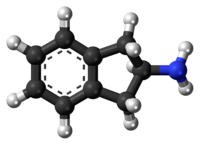2-Aminoindane
This is an old revision of this page, as edited by DePiep (talk | contribs) at 14:32, 2 April 2016 (Remove redundant parameters InChI, InChIKey (StdInChI, StdInChIKey are used). See Talk (via AWB script)). The present address (URL) is a permanent link to this revision, which may differ significantly from the current revision.
 | |
 | |
| Clinical data | |
|---|---|
| Other names | 2-indanylamine; 2-indanamine |
| Routes of administration | Oral |
| ATC code |
|
| Legal status | |
| Legal status |
|
| Identifiers | |
| |
| CAS Number | |
| PubChem CID | |
| ChemSpider |
|
| CompTox Dashboard (EPA) | |
| ECHA InfoCard | 100.019.111 |
| Chemical and physical data | |
| Formula | C9H11N |
| Molar mass | 133.190 g/mol g·mol−1 |
| 3D model (JSmol) | |
| |
| |
| | |
2-Aminoindane (2-AI) is a psychoactive drug and research chemical with stimulant properties. It is a rigid analogue of amphetamine and partially substitutes for it in rat discrimination tests.[1]
Chemical derivatives
There are a number of derivatives of 2-aminoindane and its positional isomer 1-aminoindane exist, including:
China
As of October 2015 2-AI is a controlled substance in China.[2]
See also
- 2-Aminodilin (2-AD)
- 2-Aminotetralin (2-AT)
- Amphetamine
References
- ^ Oberlender R, Nichols DE. (1991). "Structural variation and (+)-amphetamine-like discriminative stimulus properties". Pharmacol Biochem Behav. 38 (3): 581–586. doi:10.1016/0091-3057(91)90017-V. PMID 2068194.
- ^ "关于印发《非药用类麻醉药品和精神药品列管办法》的通知" (in Chinese). China Food and Drug Administration. 27 September 2015. Retrieved 1 October 2015.
This drug article relating to the nervous system is a stub. You can help Wikipedia by expanding it. |
- CS1 Chinese-language sources (zh)
- Drugs with non-standard legal status
- Articles with changed CASNo identifier
- ECHA InfoCard ID from Wikidata
- Chem-molar-mass both hardcoded and calculated
- Infobox-drug molecular-weight unexpected-character
- Articles without EBI source
- Chemical pages without DrugBank identifier
- Articles without KEGG source
- Articles without UNII source
- Drugboxes which contain changes to verified fields
- Drugboxes which contain changes to watched fields
- All stub articles
